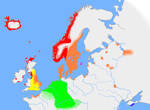Portal:Denmark/Selected article/Week 14, 2006

Danish (dansk) belongs to the North Germanic languages (also called Scandinavian languages), a sub-group of the Germanic branch of the Indo-European languages. It is spoken by around 5.5 million people mainly in Denmark including some 50,000 people in the northern parts of Schleswig-Holstein in Germany, where it holds the status of minority language. Danish also holds official status and is a mandatory subject in school in the former Danish colonies of Greenland and the Faroe Islands, that now enjoy limited autonomy. In Iceland, which was a part of Denmark until 1944, Danish is still the second foreign language taught in schools (although a few learn Swedish or Norwegian instead).
The language started diverging from the common ancestor language Old Norse sometime during the 13th century and became more distinct from the other emerging Scandinavian national languages with the first bible translation in 1550, establishing an orthography differing from that of Swedish, though written Danish is usually far easier for Swedes to understand than the spoken language. Modern spoken Danish is characterized by a very strong tendency of reduction of many sounds making it particularly difficult for foreigners to understand and properly master, not just by reputation but by sheer phonetic reality.
Recently selected: Christiansborg Palace – Odense – Bornholm
